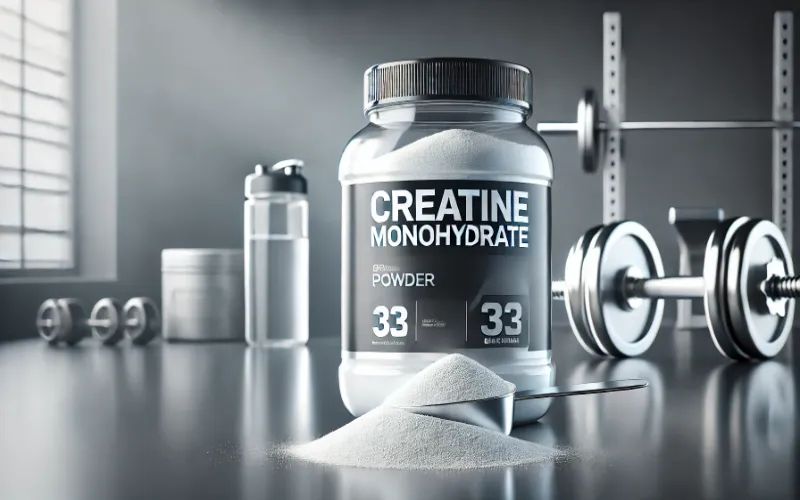Creatine monohydrate is more than just a supplement found on the shelves of gyms and health stores. It’s a naturally occurring substance, synthesized in the body and primarily stored in muscles, that plays a pivotal role in energy production.
For those who train hard and push their physical limits, creatine monohydrate serves as a potent tool to maximize performance, endurance, and muscle growth. It’s a staple for both elite athletes and fitness novices alike, lauded for its reliability and scientifically-backed efficacy.
Table of Contents
How Creatine Works in the Body
At its core, creatine monohydrate works by replenishing the body’s adenosine triphosphate (ATP) stores, which are essentially the fuel for muscle contractions. When you perform high-intensity exercises like sprinting or weightlifting, your muscles rapidly use up ATP.
Creatine steps in by donating phosphate groups to regenerate ATP, allowing your muscles to continue performing at their peak capacity for longer periods. This process gives you that extra burst of energy during short, intense bouts of activity.
Key Benefits of Creatine Monohydrate for Fitness Enthusiasts
Creatine’s popularity stems from its array of benefits, particularly for those immersed in resistance training or power-based sports.
- First and foremost, creatine is renowned for increasing muscle strength, making it an essential ally for anyone looking to lift heavier weights or improve explosive movements.
- Additionally, it has been shown to accelerate muscle mass gains, largely due to its ability to draw water into muscle cells, creating a fuller, more voluminous appearance.
- It aids in quicker recovery, reducing the time needed between sets or even after rigorous training sessions.
Creatine Monohydrate vs Other Forms of Creatine
While creatine monohydrate is the most studied and widely used form, the market offers various alternatives like creatine ethyl ester, buffered creatine, and micronized creatine. So, what sets creatine monohydrate apart? Its simplicity.
- Creatine monohydrate has a higher bioavailability, meaning your body can absorb and use it more efficiently.
- Plus, it’s often more cost-effective compared to its flashier counterparts, without compromising effectiveness.
- Other forms may claim superior absorption or fewer side effects, but scientific consensus continues to favor creatine monohydrate for its consistent performance.
Who Should Consider Taking Creatine?
Creatine isn’t just for bodybuilders or sprinters—its benefits extend to anyone engaging in physical activity.
- Whether you’re a weekend warrior, someone aiming to gain muscle mass, or an athlete striving for better performance, creatine can enhance your workouts.
- Even those participating in endurance sports, like soccer or cycling, can see improved energy retention and recovery.
- Notably, vegetarians and vegans might find creatine supplementation particularly helpful, as dietary sources of creatine are predominantly found in meat and fish.
How to Properly Use Creatine Monohydrate: Dosage and Timing
For optimal results, the standard protocol involves a loading phase where you consume 20 grams of creatine per day, split into four doses, for 5–7 days. This approach saturates the muscles more quickly.
Afterward, a maintenance dose of 3–5 grams per day keeps your muscles primed. Timing is flexible; while some prefer taking creatine before a workout, others opt for post-workout supplementation, as both strategies have shown benefits. Ultimately, consistency trumps timing, so long as you’re taking it daily.
Common Myths and Misconceptions About Creatine
Creatine has often been shrouded in myths, with detractors labeling it as unsafe or akin to anabolic steroids—neither of which is true.
- Contrary to some fears, creatine is one of the most extensively researched supplements, consistently proving to be safe for long-term use.
- Some also mistakenly believe creatine causes bloating, but this is generally only a temporary side effect during the loading phase.
- Another myth is that creatine is only effective for men; however, it has proven beneficial for women seeking improved strength and athletic performance as well.
Potential Side Effects and Safety Considerations
Creatine is remarkably safe when taken within recommended guidelines, but it’s not completely without side effects.
- The most commonly reported issue is mild gastrointestinal discomfort, particularly if consumed in high doses at once.
- Staying well-hydrated while taking creatine is crucial, as it draws water into muscle cells.
- Although concerns about kidney damage have circulated in the past, extensive research has debunked these fears in healthy individuals.
- Nevertheless, those with pre-existing kidney conditions should consult with a healthcare professional before starting creatine supplementation.
Conclusion
Creatine monohydrate is a tried-and-true supplement for athletes, fitness enthusiasts, and anyone looking to enhance physical performance. Its ability to boost energy production, increase strength, and accelerate muscle growth makes it a key player in the world of supplementation. With a wealth of scientific research backing its efficacy and safety, creatine is not only effective but also accessible to a wide range of individuals, regardless of their fitness level.
FAQs
Is creatine monohydrate safe for long-term use?
Yes, creatine monohydrate is safe for long-term use when taken within recommended dosages. Numerous studies have supported its safety for healthy individuals over prolonged periods.
Do I need to cycle creatine?
Cycling creatine is not necessary. While some choose to take breaks, continuous use at the maintenance dose (3–5 grams per day) is safe and effective.
Can women take creatine?
Absolutely! Creatine is beneficial for women looking to improve strength, endurance, and muscle mass, just as it is for men.
How long does it take to see results from creatine?
Most people begin to see noticeable improvements in strength and performance within 2–4 weeks of consistent creatine use.
Is creatine beneficial for endurance athletes?
While creatine is most associated with strength and power-based sports, it can also benefit endurance athletes by enhancing recovery and providing extra energy during high-intensity bursts.


























